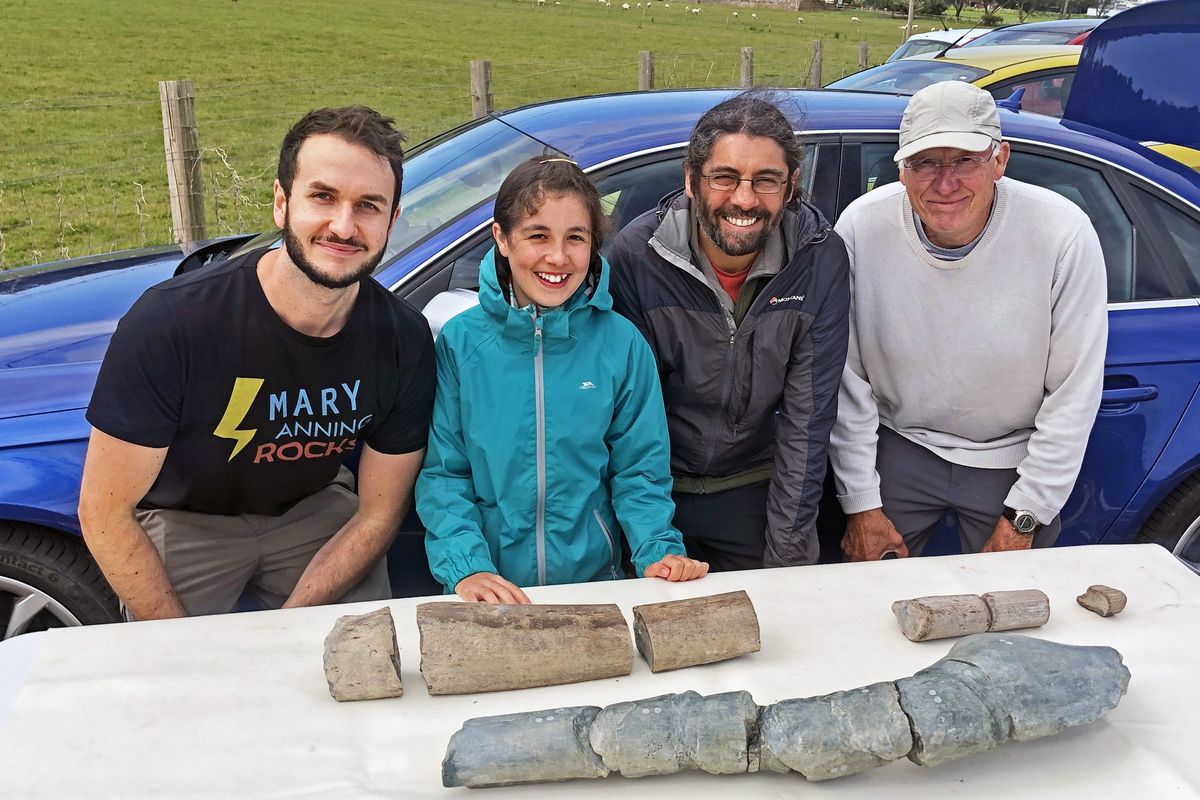Father-daughter team helps discover giant prehistoric sea beast

On a nice spring day at the end of May 2020, 11-year-old Ruby Reynolds and her dad, Justin, were fossil-hunting on Blue Anchor Beach in Somerset, England, when they discovered a fragment of a titanic sea beast.
As Justin studied the 4-inch-long, oval-shaped fossil, Ruby started to scout the slope above them. She found a second piece of fossilized bone, this one about twice as big.
Joining forces with a team of paleontologists, Justin and Ruby have now identified their find as a new species of giant ichthyosaur, a marine reptile from the Late Triassic thought to have been shaped like a modern-day dolphin. The father-daughter duo help describe the prehistoric predator in a paper published Wednesday in the journal PLOS One.
The team recovered only pieces of the animal’s lower jawbone, but they estimate that the entire creature could have stretched 80 feet – making it perhaps the biggest marine reptile yet discovered.
Justin, a postal worker who lives in the village of Braunton in Devon, didn’t know at first what he and Ruby had discovered, but after studying the fossils and doing research at home, they reached the conclusion that it was an ichthyosaur. They emailed Dean Lomax, a paleontologist and expert on the marine reptiles at the University of Manchester, for a consult.
Lomax said he gets a couple of hundred messages a year from people sending photos of potential prehistoric fossils.
“It’s interesting, because 95% of the time, it turns out to be an odd-shaped rock. You have to politely and gently let them down,” Lomax said. Justin and Ruby’s email is an example of “the other 5% of the time.”
Lomax added that he was impressed by how they independently came to the conclusion it was an ichthyosaur – and they were right.
A mysterious gap in the fossil record
Ichthyosaurs were marine reptiles that probably fed on squid and fish, swimming the seas during the age of dinosaurs. They emerged during the Early Triassic period, about 250 million years ago, and evolved into at least 150 species.
Together, Lomax and his colleagues worked with Justin and Ruby to recover more parts of the intriguing fossil from Blue Anchor. They pieced together sections of the massive lower jawbone – enough to estimate that if complete, the lower jawbone, called the surangular, would measure more than six feet long.
What was most thrilling about the find was that it added to a very similar discovery made by Lomax and colleagues in nearby Lilstock, Somerset, that they reported in 2018. They found fragments of the lower jawbone of a different giant ichthyosaur, also from a period called the Rhaetian – the end of the Triassic, about 202 million years ago.
That’s a critical time period, when ichthyosaur evolution remains something of a mystery because of a dearth of specimens, according to Neil Kelley, a paleontologist at Vanderbilt University who was not involved in the study.
Although it is only part of the jawbone, the find at Blue Anchor was more complete and better-preserved than the one from Lilstock, and finding two specimens from a similar geography and time period gave the researchers the confidence to say it is a newly identified species, which they named Ichthyotitan severnensis.
“It’s unusual to name a new species off this fragmentary of a specimen … but I mentioned this is a black-box time – we don’t have very many good ichthyosaur fossils from this time interval. That makes it pretty likely it is something new,” Kelley said.
A very large ichthyosaur
To extrapolate the size of the new specimen, researchers made comparisons with other giant ichthyosaurs, an effort that leaves some uncertainty, particularly without more pieces of the skeleton.
Lars Schmitz, a paleontologist at Claremont McKenna College, said that for him, it is not important whether this is the largest ichthyosaur. It’s undoubtedly very big – and that provides an interesting clue about the evolution of large marine reptiles.
Ichthyosaurs evolved their large body size relatively early in their watery reign, but a mass extinction event at the end of the Triassic seems to have wiped out the giants, including this species. So far, only smaller ichthyosaurs appear to have lived on into the Cretaceous period.
“I don’t care if it’s the biggest or the second biggest or third biggest,” Schmitz said. “We do have these really large marine reptiles at that time, and it adds an additional data point.”
Lomax hopes the study’s publication will make hobbyists who have hunted fossils in the region revisit their collections and keep their eyes open, perhaps turning up bones from other giant ichthyosaurs. He and colleagues have previously argued that fossils that were thought to be dinosaur bones, collected at Aust Cliff in Gloucestershire, are actually from giant ichthyosaurs, too.
As for her fossil-hunting goals, Ruby, who is now 15, wrote in an email, “I’d love to find the rest of this fossil!”